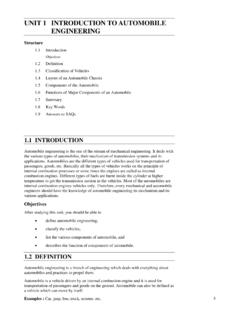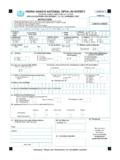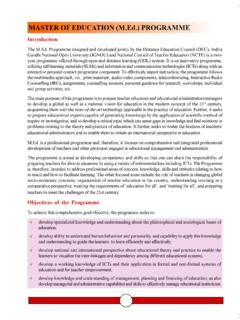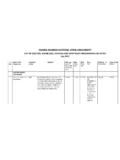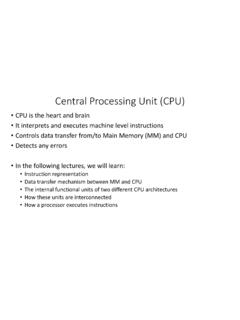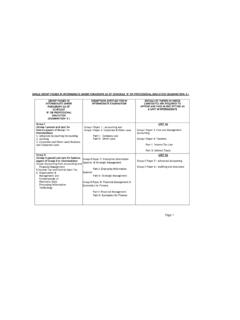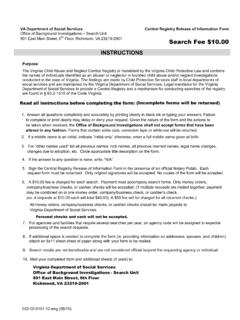Transcription of UNIT 1 INTRODUCTION TO NC MACHINE Introduction to NC …
1 INTRODUCTION to unit 1 INTRODUCTION TO NC MACHINE NC MACHINE Tools TOOLS. Structure INTRODUCTION Objectives NC Machines Types of NC MACHINE Controlled Axes Basic Components of NC Machines Problems with Conventional NC. Principles of NC Machines Summary Answers to SAQs INTRODUCTION . NC machines, advantages of NC machines, Types of NC systems, Controlled axes, Basic Components of NC Machines, Problems with Conventional NC and Principles of NC. Machines are described in this unit . Objectives After studying this unit , you should be able to understand , , , and . NC MACHINES. Controlling a MACHINE tool by means of prepared program, which consists of blocks, or series of numbers, is know as numerical control (NC).
2 In manufacturing of more complicated parts, the system has to calculate automatically additional data points, which is done by means of an interpolator. Numerical Control (NC) refers to the method of controlling the manufacturing operation by means of directly inserted coded numerical instructions into the MACHINE tool. It is important to realize that NC is not a machining method; rather, it is a concept of MACHINE control. Although the most popular applications of NC are in machining, NC can be applied to many other operations, including welding, sheet metalworking, riveting, etc. NC machines are method of automation, where automation of medium and small volume production is done by some controls under the instructions of a program.
3 Various definitions of NC are : A system in which actions are controlled by direct insertion of Numerical Data at some point. The system must automatically interpret at least some portion of this data by Electronic Industries Association (EIA). Numerical Control is defined as a form of software controlled automation, in which the process is controlled by alphanumeric characters or symbols. 5. CNC Machines According to these definitions, a programme is prepared which consists of blocks, blocks consisting of combination of characters and numbers in sequence describing the position of the tool and job, the cutting speed and feed.
4 The data converted into coded instructions which are called a Part Programme. As the job changes, the instructions of part program are also changed. The other instructions which can be included may be for tool changing or coolant on and off. It is easy to encode a new programme than to change the machinery for flexibility, thus arising the need of an NC MACHINE tool. Figure : Numerical Control (NC) MACHINE Tool Advantages of NC. The major advantages of NC over conventional methods of MACHINE control are as follows : Higher Precision NC MACHINE tools are capable of machining at very close tolerances, in some operations as small as mm.
5 Better Quality NC systems are capable of maintaining constant working conditions for all parts in a batch thus ensuring less spread of quality characteristics. Higher Productivity NC MACHINE tools reduce drastically the non machining time. Adjusting the MACHINE tool for a different product is as easy as changing the computer program and tool turret with the new set of cutting tools required for the particular part. Multi-operational Machining Some NC MACHINE tools, for example MACHINE centers, are capable of accomplishing a very high number of machining operations thus reducing significantly the number of MACHINE tools in the workshops.
6 Low Operator Qualification The role of the operation of a NC MACHINE is simply to upload the work piece and to download the finished part. In some cases, industrial robots are employed for material handling, thus eliminating the human operator. Less Time An easy adjustment of the MACHINE , adjustment requires less time. 6. Types of NC System INTRODUCTION to NC MACHINE Tools MACHINE controls are divided into three groups: (a) Traditional numerical control (NC);. (b) Computer numerical control (CNC);. (c) Distributed numerical control (DNC). The original numerical control machines were referred to as NC MACHINE tool. They have hardwired control, whereby control is accomplished through the use of punched paper (or plastic) tapes or cards.
7 Tapes tend to wear, and become dirty, thus causing misreading. Many other problems arise from the use of NC tapes, for example the need to manual reload the NC tapes for each new part and the lack of program editing abilities, which increases the lead time. The end of NC tapes was the result of two competing developments, CNC and DNC. CNC refers to a system that has a local computer to store all required numerical data. While CNC was used to enhance tapes for a while, they eventually allowed the use of other storage media, magnetic tapes and hard disks. The advantages of CNC systems include but are not limited to the possibility to store and execute a number of large programs (especially if a three or more dimensional machining of complex shapes is considered), to allow editing of programs, to execute cycles of machining commands, etc.
8 The development of CNC over many years, along with the development of local area networking, has evolved in the modern concept of DNC. Distributed numerical control is similar to CNC, except a remote computer is used to control a number of machines. An off-site mainframe host computer holds programs for all parts to be produced in the DNC. facility. Programs are downloaded from the mainframe computer, and then the local controller feeds instructions to the hardwired NC MACHINE . The recent developments use a central computer which communicates with local CNC computers (also called Direct Numerical Control). Controlled Axes NC system can be classified on the number of directions of motion they are capable to control simultaneously on a MACHINE tool.
9 Each free body has six degree of freedom, three positive or negative translations along x, y, and z-axis, and three rotations clockwise or counter clockwise about these axes. Commercial NC system is capable of controlling simultaneously two, two and half, three, four and five degrees of freedom, or axes. The NC systems which control three linear translations (3-axis systems), or three linear translations and one rotation of the worktable (4-axis systems) are the most common. Figure : Coordinate System (Milling and Drilling Operations). 7. CNC Machines Figure : Coordinate System (Turning Operations). Figure : Coordinate System (Milling and Drilling Operations).
10 Basic Components of NC Machines Software The programmes or set of instructions, languages, punched cards, magnetic tape, punched paper tape and other such information processing items are referred to as software. This software controls the sequence of movement of an NC. That is why these numerical controls are sometimes called software controlled machines by NC lies entirely in the programming. The programmer plans the operations and their sequence from seeing the drawing and writes instructions in tabulated blocks of information, known as Part Programme on a programme manuscript. Then these instructions are punched on the control tape.
